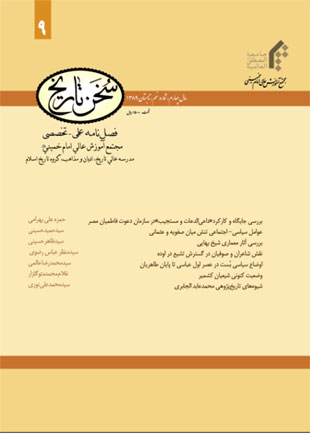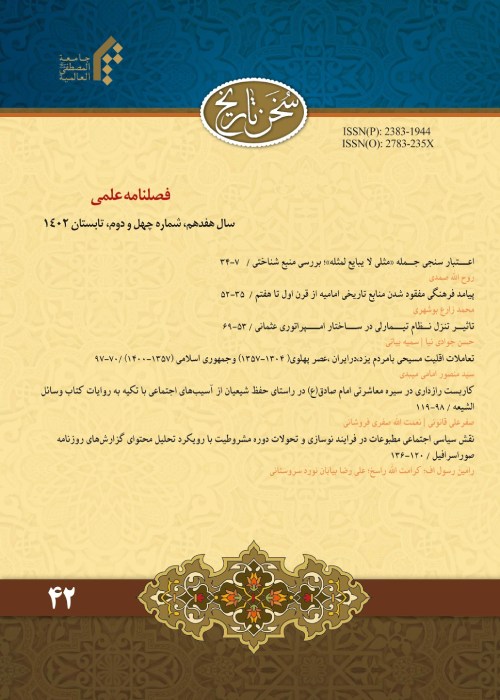فهرست مطالب

نشریه سخن تاریخ
پیاپی 9 (تابستان 1389)
- 158 صفحه، بهای روی جلد: 15,000ريال
- تاریخ انتشار: 1389/10/20
- تعداد عناوین: 8
-
صفحه 59
-
صفحه 110
-
چکیده مقالات به زبان انگلیسیصفحه 149
-
Page 3The existence of a missionary and preaching organization by the name of Dawah institution was one of the factors Ismailia had developed and progressed well. It eventually ended to establishment of one of the great Islamic empires being entitled as Fatimid in the fourth century in Morocco and Egypt. From the factors this institution operated highly efficient was its sophisticated constituents and the unique structure and mechanism it had enjoyed. From the main constituents that can be highlighted are Daie (he who invites), Daie Al Duat and Mustajeeb (he who responds) or invitee. Inthe very article the attitudes, characteristics, duties, concept, nicknames and titles, status and rank of Daei Al Duat of this institution is going to be observed and studied.
-
Page 25Shah Ismaeil Safavi has formally pioneered the Safavid dynasty in 907 (Islamic calendar). He prompted an intense socio-political competition between Iran and Ottoman and within 228 years of Safavid reign, variety of tensions stirred up and arose between them. Initially, Shah Ismaeil was governing on relatively a small part of Iran but later as soon as possible he extended his political and spiritual influence realm. Such expansion ofinfluence caused extreme concernments of Ottoman government. In this article, the backgrounds and factors which prompted socio-political tension between Safavid and Ottoman are going to be studied. From those backgrounds the prince's asylum seeking, violations of the treaties, correspondence, interference in one another's governing realm and seeking dominance of the ways had played greater role in creation of tension oravoidance of war between Iran and Ottoman. The output of this article can be an apt historical symbol in consolidation of various Islamic sects and their governments and of those painful consequences of contention amongst the Muslims. So that having all these patterns kept in mind, the next proceedings and planning should be scheduled for unification and convergence of the Islamic states.
-
Page 59Sheikh Bahaie being a prominent clergy, a man of profound thought and having a distinct vision in comparison to the rest of the clergies, had always been one of the close advisers of the first Shah Abbas. He used to be consulted in every field by the very King. Isfahan has also experienced some flourishing moments in architect during Shah Abbas and his adviser Sheikh Bahaie. This city which was chosen as a capital by Shah Abbas could enjoya great deal of masques, bridges, streets and various gardens. With the appearance of Shah Abbas and Sheikh Bahaie, the golden period of Safavid architect had started and this art became one of the most outstanding, distinguished and identity builder art of Iran. The Safavid architect put its impressions on the later periods too. The very architect owes to the preceding architect of Timurid period. Nonetheless, it could put itsimpressions inside and outside of Iran. One can see its impression on countries like India, Iraq, Caucasus, Uzbekistan, Ottoman Empire, Lahore and Florence of Italy. The Safavid period style of architect inside Iran was as complete and attractive as it was imitated in all the historical periods of Afsharia, Zandiyah, and Qajariah.
-
Page 76The role and effects played by the cultural stratums of society are more and greater than the rest of the classes'. And from amongst them the poets and Sufis can have more marvelous impression on the society. Because from one hand they enjoy social status and from other hand due to the political needs of kings and governors to them, again they enjoy somehow noteworthy positions.Avadeh's administration in India like many other governments has made the poets and Sufis to serve her interest best and in a larger scale. These two categories due to their inclinations toward Shiism have played a remarkable part in expansion of Shiism in India and particularly in Avadeh. In this writing the role played by the poets and Sufis in expansion of Shiism is going to be dealt with.
-
Page 89Prior establishment of Abbasid caliphate, the city of Bost was overthrown in the hands of their adherents. Nevertheless, due to their representative's imprudence many revolts and uprisings took place in this city which eventually ended to Khawarij dominance of the area. The Abbasid Caliphs launched several proceedings to calm the situation but failed to achieve any conclusion. Another faction called Mutawwiah seeing the condition startedto oppose the Khawarij blatantly. Meanwhile in this condition the cities such as Khorasan, Sistan and Bost were overthrown in the hands of Tahirid who had just raised the flag of independence. Simultaneously another group called Ayyaran came into being in Bost. This group alongside launching a series of uprisings against Tahirid government could resist against Khawarij and gradually got changed to be the superpower of the region (city of Bost) and with the initiation of Jacob Laith's government in Bost, the backgroundsof a great administration of Safari were prepared.
-
Page 110The present Kashmiri Shiites are divided into four leading groups. This factionalism and group division fact has caused that they should have dissention even in the daily and routine affairs. The Shiites are economically weaker in comparison to the rest of the sects. Thus they force their children to be busy in carpet making shops. The Shiites are not present even in two percent of governmental (central and provincial) employment opportunities, while their population percentage is at least 15%. Literacy rate amongst the men of the Shiites is 10 to 15 percent while this number lessens to 5 to 6 %amongst their female gender.
-
Page 128Muhammad Aabid Al Jabiri launching a series of researches in various fields has created some important works. He in his project called "criticism of Arabic intellect" has dealt with some significant historical issues. He employing the recent methods of history research started to criticize the Islamic culture and civilization in the frame work of history of Islam. His history research methods are generally of two kinds. The methods which are applied in his entire works such as (the theoretical foundations, ethics and his regional studies) and the methods which have been used exclusively in the history of Islam as: tribe, booty and belief. These were the new exclusive methods which Jabiri has utilized for recitation and understanding of the history of Islam. These three keywords (tribe, booty and belief) are the concepts which he borrows from the western intellectuals. He tries tocustomize and use these concepts in the history of Islam


